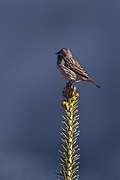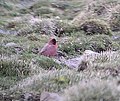| Image | Common name | Scientific name | Distribution |
|---|
 | Common rosefinch | Carpodacus erythrinus | Asia and Europe. |
 | Scarlet finch | Carpodacus sipahi | the Himalayas from Uttarakhand state in the Indian Himalayas eastwards across Nepal, stretching further east to the adjacent hills of Northeast India and Southeast Asia as far south as Thailand. |
| †Bonin grosbeak | Carpodacus ferreorostris (extinct) | Chichi-jima in the Ogasawara Islands. |
 | Streaked rosefinch | Carpodacus rubicilloides | Bhutan, China, India, and Nepal. |
 | Great rosefinch | Carpodacus rubicilla | Afghanistan, Azerbaijan, Georgia, Kazakhstan, Kyrgyzstan, Mongolia, Pakistan, Russia, Tajikistan, and Uzbekistan and east to China |
 | Blyth's rosefinch | Carpodacus grandis | northern Afghanistan to the western Himalayas. |
 | Red-mantled rosefinch | Carpodacus rhodochlamys | in Afghanistan, China, India, Kazakhstan, Mongolia, Pakistan, Russia, and Tajikistan. |
 | Himalayan beautiful rosefinch | Carpodacus pulcherrimus | mid-western China and the northern Himalayas. |
| Chinese beautiful rosefinch | Carpodacus davidianus | China |
| Pink-rumped rosefinch | Carpodacus waltoni | central China and eastern Tibet |
 | Pink-browed rosefinch | Carpodacus rodochroa | Bhutan, Tibet, India, Nepal, and Pakistan. |
 | Dark-rumped rosefinch | Carpodacus edwardsii | Bhutan, China, India, Myanmar, and Nepal. |
| Spot-winged rosefinch | Carpodacus rodopeplus | India and Nepal |
| Sharpe's rosefinch | Carpodacus verreauxii | central China and far northern Myanmar. |
 | Vinaceous rosefinch | Carpodacus vinaceus | Nepal, China and far northern Myanmar. |
 | Taiwan rosefinch | Carpodacus formosanus | Taiwan |
 | Sinai rosefinch | Carpodacus synoicus | Egypt, Israel, Jordan, and Saudi Arabia. |
| Pale rosefinch | Carpodacus stoliczkae | Afghanistan and China |
 | Tibetan rosefinch | Carpodacus roborowskii | Xinjiang Autonomous Region. |
| Sillem's rosefinch | Carpodacus sillemi | China, Japan, Kazakhstan, North Korea, South Korea, and Russia. |
 | Siberian long-tailed rosefinch | Carpodacus sibiricus | Japan, Kazakhstan, North Korea, South Korea, Mongolia, and Russia. |
| Chinese long-tailed rosefinch | Carpodacus lepidus | China |
 | Pallas's rosefinch | Carpodacus roseus | China, Japan, Kazakhstan, North Korea, South Korea, Mongolia, and Russia. |
| Three-banded rosefinch | Carpodacus trifasciatus | central China and far northeastern India. |
 | Himalayan white-browed rosefinch | Carpodacus thura | Afghanistan, Bhutan, India, Nepal, and Pakistan. |
 | Chinese white-browed rosefinch | Carpodacus dubius | central China and eastern Tibet. |
 | Red-fronted rosefinch | Carpodacus puniceus | Afghanistan, Bhutan, China, India, Kazakhstan, Nepal, Pakistan, Russia, Tajikistan, and Turkmenistan |
 | Crimson-browed finch | Carpodacus subhimachalus | Bhutan, China, India, Myanmar, and Nepal. |
|



















